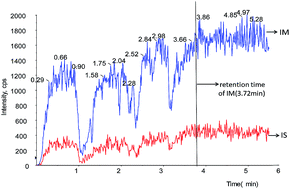A liquid chromatography-tandem mass spectrometry method for the quantitation of imidafenacin in human plasma: application to a clinical pharmacokinetic study
Abstract
Imidafenacin (IM), a novel antimuscarinic agent with safety and efficacy, has been clinically used for the treatment of overactive bladder. A simple, sensitive, and selective method for the quantitative determination of IM in human plasma using liquid chromatography combined with heated electrospray ionization tandem mass spectrometry (LC-MS/MS) was validated. After protein precipitation, samples were separated by HPLC on a Phenomenex Synergi 4 μm Hydro-RP 80 Å (150 mm × 2.0 mm) column with mobile phases of 0.2 mM ammonium formate in water with 0.01% formic acid and acetonitrile. The mass instrument was operated in the positive electrospray ionization mode and the monitored transition was set at m/z 320.3 → 238.0 and m/z 496.4 → 261.0 for the IM and IS (silodosin), respectively. The stability, selectivity, recovery, precision, and accuracy were acceptable in the validated tests. The method was successfully validated in the concentration range of 10–1000 pg mL−1 in human plasma for a clinical pharmacokinetic study.


 Please wait while we load your content...
Please wait while we load your content...